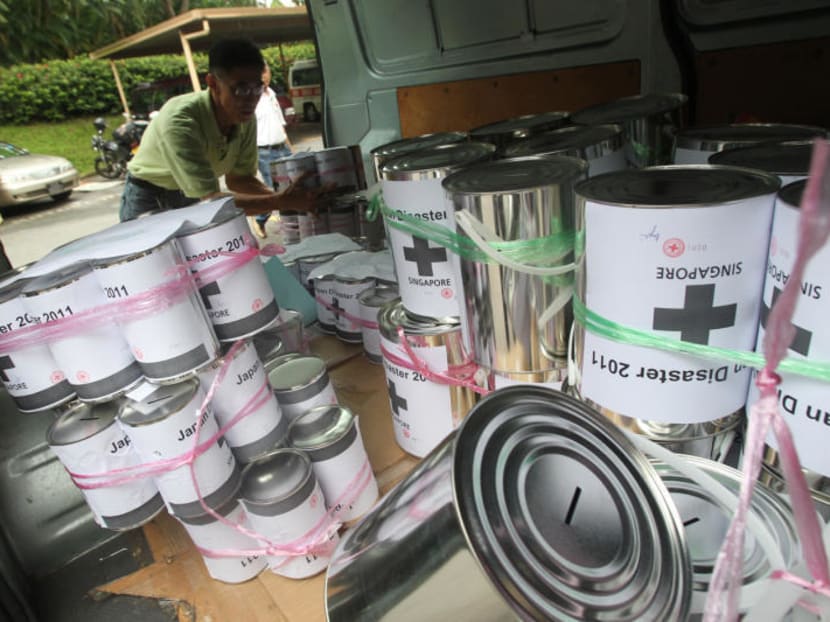Tax-deductible donations fell sharply last year: COC
SINGAPORE — The amount of money received by Institutions of a Public Character (IPC) through tax-deductible donations hit a six-year low last year, following 2015's high which was spurred by higher tax deductions marking Singapore's Golden Jubilee.

A deliveryman loading donation tins into a van at the Red Cross Singapore headquarters. TODAY file photo
SINGAPORE — The amount of money received by Institutions of a Public Character (IPC) through tax-deductible donations hit a six-year low last year, following 2015’s high which was spurred by higher tax deductions marking Singapore’s Golden Jubilee.
Last year’s total of S$865.6million was 36 per cent lower than the S$1.361 billion donated in 2015, according to the Commissioner of Charities’ (COC) annual report released yesterday.
The last time the total was lower was in 2010, when it was S$776.1 million.
The sharp drop was partly due to tax deduction reverting to S$2.50 deducted from taxable income for the year for each dollar donated; the rate was 300 per cent in 2015.
The COC added that economic uncertainty may also have had an “adverse effect on charitable giving”, but expressed confidence that the public would continue to support local charitable causes.
IPCs are charities allowed to issue tax-deductible receipts to donors wanting to claim tax relief.
They must serve a broader segment of society and not be confined to specific groups based on race, belief or religion.
The fall in tax-deductible donations could also be due to donations “shifting from IPCs to certain non-IPCs like religious charities”, said National University of Singapore associate professor of accounting Mak Yuen Teen.
Other factors besides the reversion of tax deduction rate were at play, given the six-year low in such donations, he noted.
“Tax deductibility of donations is more important to corporate donors and those in high income brackets,” he said. For others, factors such as the resonance of a charity’s mission may be more important.
Total donations to all charities in 2015 — the latest figures available — amounted to more than S$2.7billion, of which more than 40 per cent went to religious charities. In 2014, total donations to all charities stood at about S$2.5billion, according to the report.
Economic transformation may have affected some sectors and well-off individuals, said Nee Soon group representation constituency Member of Parliament Henry Kwek, of the Government Parliamentary Committee for Culture, Community and Youth.
The Cat Welfare Society was among IPCs that saw lower tax-deductible donations last year. It had to cut back on sterilisation of community cats — from more than 4,900 sterilised in 2015, to fewer than 4,200 last year, according to executive director Laura Ann Meranda.
The group also faced higher costs including vet bills.
As in previous years, IPCs in the social and welfare, education and health sectors attracted the bulk of tax-deductible donations (80.9 per cent), vastly more than IPCs in areas like sports, arts and heritage, community and other sectors.
The proportion of tax-deductible donations from corporates fell to its lowest in at least a decade to 53.5 per cent last year.
They donated S$462.7 million, with the remaining S$402.9 million coming from individuals.
COC Ang Hak Seng said new ways of fundraising and technological advancements are changing the global charity landscape. Charities need to “evolve and adapt”, he said.
His office will be raising public awareness of informed giving. With websites, donors should be aware of the terms and conditions, as well as their fee structures, said Dr Ang.
Assoc Prof Mak said charities must manage the risks technology brings, but could make more use of social media and online platforms.
Charities can use apps to help “make the volunteering journey more convenient and meaningful” for supporters, added Mr Kwek.
In his annual report message, Dr Ang also reiterated his predecessor Low Puk Yeong’s concern that charities face the risk of being exploited for terrorist financing.
An ongoing review of the Charities Act, which began in 2015, seeks to increase accountability of charities and fundraisers in Singapore. It will also give stronger regulatory powers to the Commissioner.
Meanwhile, the number of registered charities continues to grow. The 2,247 registered charities last year was 30 more than in 2015, and a 19 per cent increase from 2007.
Religious, as well as social and welfare organisations, accounted for nearly two-thirds of all charities.
Around 46 per cent of registered charities were “relatively small”, with annual receipts (including donations and government grants) of less than S$250,000 in 2015, according to the annual report.
However, registered charities have slowly grown larger in size over the years, it noted. There were 179 large charities in 2015 with annual receipts above S$10 million, 11.9 per cent more than the 160 large charities in 2014.
Total receipts of the charity sector rose to S$16.4 billion in 2015, up from S$14.6 billion in 2014. Charities in the education sector accounted for S$9.8 billion, or 60 per cent, of total receipts.






